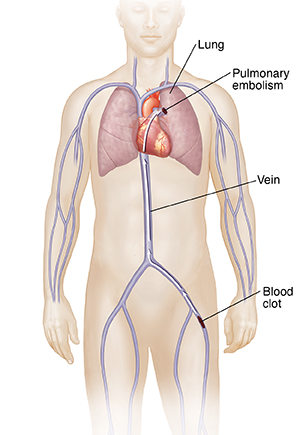A
B
C
D
E
F
G
H
I
J
K
L
M
N
O
P
Q
R
S
T
U
V
W
X
Y
Z
Topic IndexLibrary Index
Click a letter to see a list of conditions beginning with that letter.
Click 'Topic Index' to return to the index for the current topic.
Click 'Library Index' to return to the listing of all topics.
Complications of Deep Vein Thrombosis
Deep vein thrombosis (DVT) is a condition where a blood clot (thrombus) forms in a deep vein. It may develop in a large vein deep inside the leg, arm, or other part of the body. Complications from DVT can be very serious. They can include pulmonary embolism (PE), chronic venous insufficiency, and post-thrombotic syndrome.
You may hear healthcare providers use the term venous thromboembolism (VTE) to describe DVT and PE. They use the term VTE because these conditions are very closely linked. And because their prevention and treatment are closely linked.
Pulmonary embolism
Pulmonary embolism (PE) happens when part of the clot, called an embolus, separates from the vein. It goes to the lungs and cuts off blood flow. A PE may develop quickly. It's a medical emergency and may cause death.

Call 911
Call 911 if you have symptoms of a blood clot in the lungs. Symptoms may include:
You may have bleeding if you take medicine to help prevent blood clots. Call 911 if you have heavy or uncontrolled bleeding.
When to call your healthcare provider
Call your healthcare provider if any of these occur:
-
You have symptoms of a blood clot, such as:
-
You have symptoms of bleeding, such as:
Chronic venous insufficiency and post-thrombotic syndrome
Two other complications of DVT are chronic venous insufficiency and post-thrombotic syndrome.
Chronic venous insufficiency. This may happen following DVT of a leg vein. It means that a vein no longer works as well. It's a long-term condition where blood stays in the vein instead of flowing back to the heart. Pain and swelling in the leg are common symptoms.
Post-thrombotic syndrome. This may also happen after DVT of a leg vein. It's a long-term problem with pain, swelling, and redness. Ulcers and sores can also happen if the condition isn't treated early. These complications and related symptoms may make it hard to walk and take part in daily activities.
Online Medical Reviewer:
Chris Southard RN
Online Medical Reviewer:
Marianne Fraser MSN RN
Online Medical Reviewer:
Melinda Murray Ratini DO
Date Last Reviewed:
3/1/2024
© 2000-2024 The StayWell Company, LLC. All rights reserved. This information is not intended as a substitute for professional medical care. Always follow your healthcare professional's instructions.